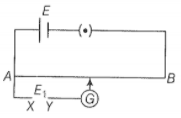While doing an experiment with a potentiometer (figure), it was found that the deflection is one-sided and (i) the deflection decreased while moving from one end A of the wire to the end B; (ii) the deflection increased, while the jockey was moved towards the end B.

(i) Which terminal, positive or negative of the cell , is connected at X in case (i) and how is related to E?
(ii) Which terminal of the cell is connected at X in case (ii)?

© 2026 GoodEd Technologies Pvt. Ltd.